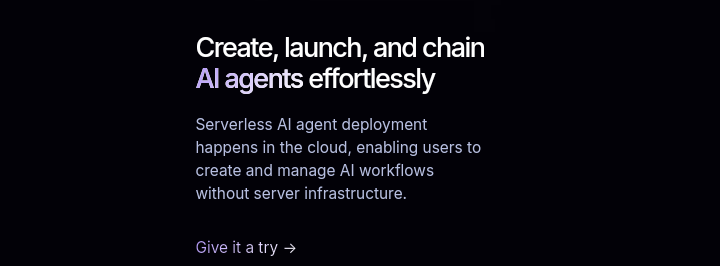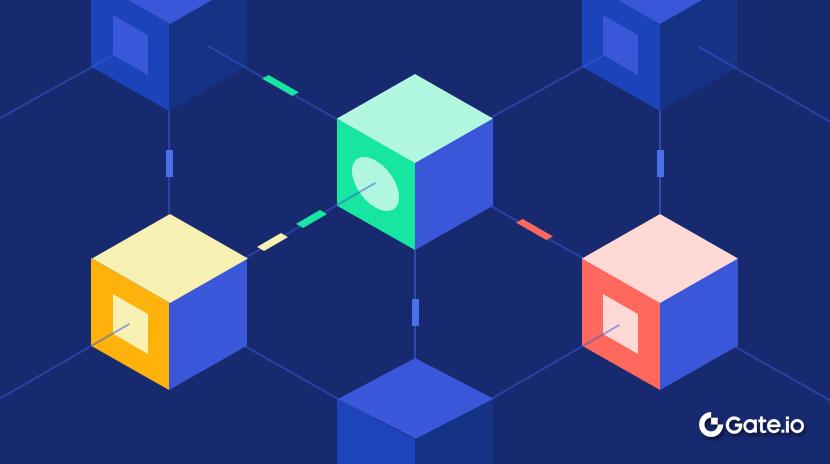SwarmNode: Майбутнє розгортання безсерверних штучних інтелектуальних агентів
Дізнайтеся про SwarmNode, платформу розгортання безсерверних штучних інтелектуальних агентів, що працює на SNAI токені. Дізнайтеся, як вона спрощує оркестрацію агентів на основі хмари, зменшує витрати та надає розробникам масштабовані інструменти автоматизації в реальному часі.Запуск AI агентів цілодобово є дорогим, часомістким та часто недоступним для звичайних розробників. Традиційні методи розгортання вимагають постійного управління серверами, нагляду за інфраструктурою та високих щомісячних підписок, навіть коли агенти неактивні. Для розробників з великими ідеями, але обмеженими ресурсами, ці технічні та фінансові бар'єри можуть загальмувати інновації. Бізнеси та творці однаково опиняються в складностях DevOps, коли вони повинні зосередитися на створенні розумних, корисних AI агентів. У світі, що швидко рухається в напрямку автоматизації AI, критично необхідний більш простий, розумний рішення, яке надає перевагу простоті, гнучкості та масштабованості.
SwarmNode пропонує революційний підхід: платформу, спеціально побудовану для штучних інтелектуальних агентів, яка не потребує серверів та є хмарно-орієнтованою. Замість управління інфраструктурою, розробники можуть завантажувати агентів на основі Python, встановлювати розклади та запускати виконання через API або SDK, платячи тільки за фактичне використання. З такими функціями, як послідовне з'єднання агентів, постійне сховище та гнучка оркестрація, SwarmNode усуває складність, дозволяючи користувачам створювати потужні системи штучного інтелекту, які працюють за подіями.
Що таке Нода Swarm?

SwarmNode - це хмарний, безсерверний платформа, що дозволяє розробникам будувати, розгортати та керувати штучними інтелектуальними агентами, не займаючись традиційною інфраструктурою. Заснований Бакаром Тавадзе, досвідним інженером-розробником штучного інтелекту, SwarmNode був створений для спрощення виконання, масштабування та монетизації розумних агентів. Користувачі пишуть сценарії Python з простою функцією main(), завантажують їх через інтерфейс користувача, REST API або SDK, і SwarmNode обробляє все від налаштування середовища до виконання.
Місія та візія SwarmNode
Місія SwarmNode полягає в демократизації доступу до масштабованої інфраструктури штучного інтелекту шляхом усунення бар'єрів, таких як вартість, складність та управління серверами. SwarmNode надає можливість творцям, розробникам та бізнесу втілити ідеї, що працюють на штучному інтелекті, без будь-яких накладних витрат на DevOps, надаючи готову до використання систему для розгортання агентів. Платформа уявляє майбутнє, де тисячі розумних агентів, побудованих глобальною спільнотою, працюють автономно в різних галузях, автоматизуючи все від маркетингових досліджень до створення контенту.
Технологія за SwarmNode

Архітектура безсерверна
Архітектура безсерверної СвармНоду абстрагує необхідність управління серверною інфраструктурою користувачів. У цій моделі розробники завантажують свій код агента, а платформа відповідає за розгортання, масштабування та розподіл ресурсів. Розробники не потребують управління серверами, налаштування хмарних екземплярів або стурбованості щодо часу роботи. Кожний штучний інтелект агента працює в ізольованому середовищі за потреби. СвармНода автоматично забезпечує створення середовища, масштабує робочий час агента та завершує неактивні екземпляри.
SwarmNode використовує модель плати за фактом використання з виставленням рахунків за кожну секунду виконання агента. Це протистоїть традиційним хмарним послугам, які часто стягують плату за повний місяць (720 годин), незалежно від використання, що робить SwarmNode вигідним для криптокористувачів зі змінними робочими навантаженнями. Переваги включають в себе більш низькі витрати для початківців, автоматичне масштабування для обробки піків в попиті та зменшення технічних бар'єрів для тих, хто новий у хмарних обчисленнях.
Легкі агенти на основі Python
Штучні інтелект агенти SwarmNode реалізовані на Python, мові, обраній через її простоту та величезні бібліотеки для штучного інтелекту та машинного навчання, такі як TensorFlow та Pandas. Агенти мають мінімальні залежності та низькі вимоги до ресурсів, що відповідає серверному дизайну платформи. Ця легкість дозволяє швидке розгортання та виконання, дозволяючи розробникам швидко запускати агентів та вимикати їх у режимі очікування. Наприклад, агент, який аналізує тенденції на криптовалютному ринку, може працювати декілька секунд, обробляти дані, а потім засинає до наступного спрацювання. Використання Python підтримується SDK, що робить його доступним для початківців для написання та розгортання агентів без глибоких знань інфраструктури.
Python також сприяє інтеграції з наявними криптозасобами та бібліотеками, такими як засоби аналізу даних on-chain або взаємодії DeFi. Ця простота дозволяє розробникам зосередитися на логіці, а не турбуватися про налаштування бекенду. Агенти також можуть обробляти навантаження та повертати вихідні дані у форматі JSON, що полегшує їх ланцюження, моніторинг та інтеграцію в більш широкі робочі процеси.
Ланцюжковий агент та рої в логіці
Ланцюжок агентів і логіка рою є основними технологіями, що лежать в основі функціональності SwarmNode, що забезпечує спільні робочі процеси між агентами штучного інтелекту. Ланцюжок агентів — це здатність агентів послідовно передавати дані або завдання, коли вихідні дані одного агента стають вхідними даними для іншого. Наприклад, агент може збирати дані про ціни криптобіржі в режимі реального часу, інший може аналізувати тенденції, а третій може генерувати торгові сигнали на основі аналізу. Логіка рою розширює цю концепцію, дозволяючи декільком агентам динамічно працювати як «рій». Це може включати розподіл завдань між агентами для паралельної обробки, наприклад, аналіз кількох криптоактивів одночасно або координацію для вирішення складних проблем, з якими жоден агент не може впоратися поодинці.
Інструменти оркестрування, включаючи REST API та Python SDK, полегшують це ланцюгування. SDK надає простий інтерфейс для розробників для керування взаємодією агента, контролюючи коли і як дані передаються між агентами. Це надзвичайно важливо для користувачів криптовалют, оскільки це дозволяє обробку даних у реальному часі та автоматизоване прийняття рішень, наприклад, в арбітражі DeFi або аналізі даних on-chain.
Постійне та спільне збереження у хмарі
SwarmNode надає постійне та спільне хмарне сховище, що є важливим для забезпечення неперервності даних та сприяння співпраці агентів. Постійне сховище забезпечує збереження даних, створених агентом, протягом часу, навіть коли агенти запускаються та припиняють свою роботу, тоді як спільне сховище дозволяє кільком агентам отримувати доступ до одного й того ж пулу даних. Ця функціональність реалізується за допомогою хмарних баз даних або об'єктних служб сховищ. Наприклад, агент, який аналізує історичні дані про ціни, може зберігати результати в спільній базі даних, яку потім зможе використовувати інший агент для прогнозування або звітування. Цей спільний доступ є важливим для децентралізованих додатків, забезпечуючи співпрацю агентів без дублювання зусиль.
Гнучке виконання та оркестрація
SwarmNode пропонує гнучке виконання та оркестрацію, дозволяючи розробникам контролювати спосіб та час виконання агентів. Це означає, що агенти можуть бути запущені різними способами: вручну через користувацький інтерфейс, програмно за допомогою його Python SDK або REST API, заплановані для виконання у певні часи або активовані відповідно до подій, таких як новий блок на блокчейні чи перетнення порогу ціни.
Оркестрація включає управління послідовністю та залежностями між агентами, забезпечуючи їх виконання в правильному порядку та плавний потік даних. Це може бути досягнуто за допомогою конструкторів робочих процесів, керування на основі API або попередньо визначених шаблонів. Ця гнучкість є важливою для криптовалютних додатків, де часування та автоматизація є критичними. Це дозволяє початківцям експериментувати з простими розкладами, тоді як проміжні користувачі можуть створювати складні, подійно-орієнтовані робочі процеси, такі як автоматизація стратегій арбітражу DeFi на основі змін цін у реальному часі.
Середовище спрямоване на розробників
SwarmNode розроблений з увагою до розробників, пропонуючи ряд інструментів та функцій для оптимізації процесу розробки. Платформа надає SDK на кількох мовах програмування, з фокусом на Python та заплановану підтримку інших мов, таких як Rust та TypeScript. Ці SDK дозволяють розробникам створювати, налаштовувати та керувати агентами, інтегруючись безшовно з існуючими кодовими базами.
Це також включає зручний інтерфейс для відстеження продуктивності агента, відстеження використання ресурсів та відлагодження проблем. Особливості, такі як контроль версій для коду агента, реальний час ведення журналу та метрики продуктивності, включені. Крім того, SwarmNode надає вичерпну документацію, яка керує користувачів через налаштування та розгортання, знижуючи бар'єр для початківців.
Основні функції SwarmNode
SwarmNode - не просто ще одна платформа штучного інтелекту - це повноцінне рішення для розгортання розумних агентів з високою точністю, швидкістю і мінімальними тертями. Його функції адаптовані для задоволення потреб як індивідуальних розробників, так і корпоративних команд, поєднуючи простоту серверного програмування з міцною оркестрацією. Нижче наведено основні функції, які роблять SwarmNode видатним у ІТ-інфраструктурі.
Розгортання безсерверних застосунків
SwarmNode видаляє інфраструктурні бар’єри, дозволяючи розгортання безсерверних штучних інтелектуальних агентів. Розробники не повинні керувати віртуальними машинами або контейнерними кластерами. Замість цього вони просто пишуть код на Python, завантажують його та виконують. Це оптимізує процес, зменшує операційні витрати та прискорює виходження на ринок. Агенти автоматично масштабуються в залежності від попиту, зберігаючи ресурси та забезпечуючи оптимальну продуктивність.Економічна модель тарифікації
На відміну від традиційних хмарних сервісів, які рахують за години або вимагають тривалого часу безперервної роботи сервера, SwarmNode бере плату лише за фактичну кількість секунд, протягом яких працює агент. Немає потреби переплачувати за бездіяльні ресурси. Ця модель оплати за виконання є привабливою для експериментів, ітераційного розвитку та робочих процесів масштабного обсягу.Ланцюження та модулярні рої
Найбільшею функцією SwarmNode є можливість ланцюгового з'єднання кількох агентів. Агенти можуть передавати дані вниз по потоці іншим агентам, створюючи узгоджену систему - або «рій» - процесів штучного інтелекту. Цей модульний підхід дозволяє створювати масштабовані, повторно використовувані компоненти, які працюють разом безперешкодно для вирішення складних завдань у розподіленому режимі.Вбудований сховище для управління станом
SwarmNode включає постійне сховище ключ-значення, з якого агенти можуть читати та писати під час виконання. Ця модель спільної пам'яті дозволяє виконання операцій у стані, комунікацію багатьох агентів та збереження даних між запусками - важлива функція для додатків у реальному часі, персоналізації користувача та співпраці між агентами.Гнучке виконання через API, SDK або UI
Незалежно від того, чи ви автоматизуєте завдання, плануєте рутина або інтегруєте робочі процеси з штучним інтелектом у своє додаток, SwarmNode пропонує гнучкі шляхи виконання. Запускайте агентів через інтуїтивну панель, REST API або Python SDK. Це робить платформу доступною для всіх рівнів навичок і легко вбудовуваною в існуючі системи.Екосистема розробників та шаблони
З ростучим ринком шаблонів та програмами нагород, SwarmNode сприяє екосистемі, спрямованій на розвиток розробників. Користувачі можуть використовувати готові агенти, налаштовувати робочі процеси та монетизувати свої створення за допомогою внутрішнього токену SNAI. Це стимулює інновації та взаємопроникнення в спільноті.
Токеноміка SwarmNode (SNAI)

У основі екосистеми SwarmNode лежить $SNAI, внутрішній корисний токен, який забезпечує операції, стимулює участь і керує еволюцією платформи. Розроблений з урахуванням прозорості та сталості, токеноміка $SNAI відображає зобов'язання SwarmNode до довгострокового зростання та інновацій на користь розробників.
Загальний Обсяг
SwarmNode має фіксований обсяг 1 000 000 000 токенів $SNAI, що забезпечує дефіцит та збереження вартості на довгостроковий період. Ця межа означає, що немає ризику інфляційного друку токенів, що часто може розбавити вартість у подібних екосистемах.
Утиліті
$SNAI - це не просто об'єкт спекуляції - це справжній утилітарний токен. Користувачі можуть:
- Розгортайте та виконуйте агентів за допомогою SNAI
- Заробляйте SNAI, будуючи або виконуючи винагороди
- Утримуйте принаймні 1000 SNAI, щоб розблокувати безкоштовні привілеї виконання агента
- Керуйте оновленнями та рішеннями платформи, оскільки SwarmNode досліджує децентралізоване управління
Як почати роботу з Нодою Swarm
SwarmNode дозволяє легко розгортати штучні інтелектуальні агенти в хмарі. Зручний інтерфейс, вбудовані SDK та модель оплати за фактом використання дозволяють розробникам почати працювати за кілька хвилин, не турбуючись про інфраструктуру чи обслуговування серверів. Чи ви запускаєте свого першого агента чи масштабуєте складні робочі процеси, ось з чого почати.

Крок 1: Створіть безкоштовний обліковий запис
Відвідати SwarmNode.aiі зареєструйтеся на безкоштовний обліковий запис. Нові користувачі отримують безкоштовний час виконання для тестування платформи та дослідження її основних функцій. Не потрібно передоплати—просто стрибайте і починайте будувати.

Крок 2: Побудуйте свого першого агента
Перейдіть на панель створення агента NaviGate.com. Тут ви визначите свого агента, використовуючи три компоненти:
- Сценарій - Ваш код Python з функцією main().
- Вимоги - Будь-які зовнішні пакети Python, від яких залежить ваш скрипт.
- Змінні середовища – Опційні змінні, такі як ключі API або конфігурації.
Ви можете писати свій скрипт безпосередньо в наданому редакторі коду або використовувати SDK для його завантаження.

Крок 3: Розгорнути та виконати
Після побудови вашого агента SwarmNode компілює його і готує до виконання. Ви можете:
- Запустіть його вручну через користувацький інтерфейс
- Заплануйте його за допомогою виразів cron
- Активуйте його через REST API або Python SDK
Крок 4: Моніторинг журналів та значень повернення
Відстежуйте продуктивність вашого агента за допомогою живих журналів та значень повернення, доступних з панелі інструментів або за допомогою SDK. Це ідеально підходить для налагодження, моніторингу або вдосконалення поведінки.

Крок 5: Досліджуйте шаблони та ланцюжки рою
Перевірте ринок для передбудованих шаблонів агентів, які ви можете налаштувати. Хочете, щоб агенти співпрацювали? Використовуйте ланцюжок агентів для побудови роїв, які спільно вирішують складні завдання.
Висновок
SwarmNode переосмислює спосіб, яким розробники створюють та розгортають AI агентів, пропонуючи безсерверну, дружелюбну для розробників платформу, що працює на базі токена SNAI. З фокусом на простоту, вартісність та масштабованість, вона знижує бар'єри для інновацій в галузі штучного інтелекту та відкриває нові можливості для автоматизації в різних галузях. При розвитку таких функцій, як шаблони та покращена оркестрація, SwarmNode готовий очолювати безсерверний штучний інтелект у криптопросторі, де розробники можуть оживляти розумних агентів без необхідності серверів.
Пов’язані статті

Детальний опис Yala: створення модульного агрегатора доходності DeFi з $YU стейблкоїном як посередником

Все, що вам потрібно знати про Blockchain

Що таке Стейблкойн?

Що таке Gate Pay?

Що таке Axie Infinity?


